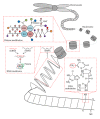The genetic architecture of multiple myeloma
- PMID: 24803933
- PMCID: PMC3996928
- DOI: 10.1155/2014/864058
The genetic architecture of multiple myeloma
Abstract
Multiple myeloma is a malignant proliferation of monoclonal plasma cells leading to clinical features that include hypercalcaemia, renal dysfunction, anaemia, and bone disease (frequently referred to by the acronym CRAB) which represent evidence of end organ failure. Recent evidence has revealed myeloma to be a highly heterogeneous disease composed of multiple molecularly-defined subtypes each with varying clinicopathological features and disease outcomes. The major division within myeloma is between hyperdiploid and nonhyperdiploid subtypes. In this division, hyperdiploid myeloma is characterised by trisomies of certain odd numbered chromosomes, namely, 3, 5, 7, 9, 11, 15, 19, and 21 whereas nonhyperdiploid myeloma is characterised by translocations of the immunoglobulin heavy chain alleles at chromosome 14q32 with various partner chromosomes, the most important of which being 4, 6, 11, 16, and 20. Hyperdiploid and nonhyperdiploid changes appear to represent early or even initiating mutagenic events that are subsequently followed by secondary aberrations including copy number abnormalities, additional translocations, mutations, and epigenetic modifications which lead to plasma cell immortalisation and disease progression. The following review provides a comprehensive coverage of the genetic and epigenetic events contributing to the initiation and progression of multiple myeloma and where possible these abnormalities have been linked to disease prognosis.
Figures





References
-
- Kyle RA, Therneau TM, Rajkumar SV, et al. Prevalence of monoclonal gammopathy of undetermined significance. The New England Journal of Medicine. 2006;354(13):1362–1369. - PubMed
-
- Kyle RA, Therneau TM, Vincent Rajkumar S, et al. A long-term study of prognosis in monoclonal gammopathy of undetermined significance. The New England Journal of Medicine. 2002;346(8):564–569. - PubMed
-
- Kyle RA, Remstein ED, Therneau TM, et al. Clinical course and prognosis of smoldering (asymptomatic) multiple myeloma. The New England Journal of Medicine. 2007;356(25):2582–2590. - PubMed
Publication types
LinkOut - more resources
Full Text Sources
Other Literature Sources

